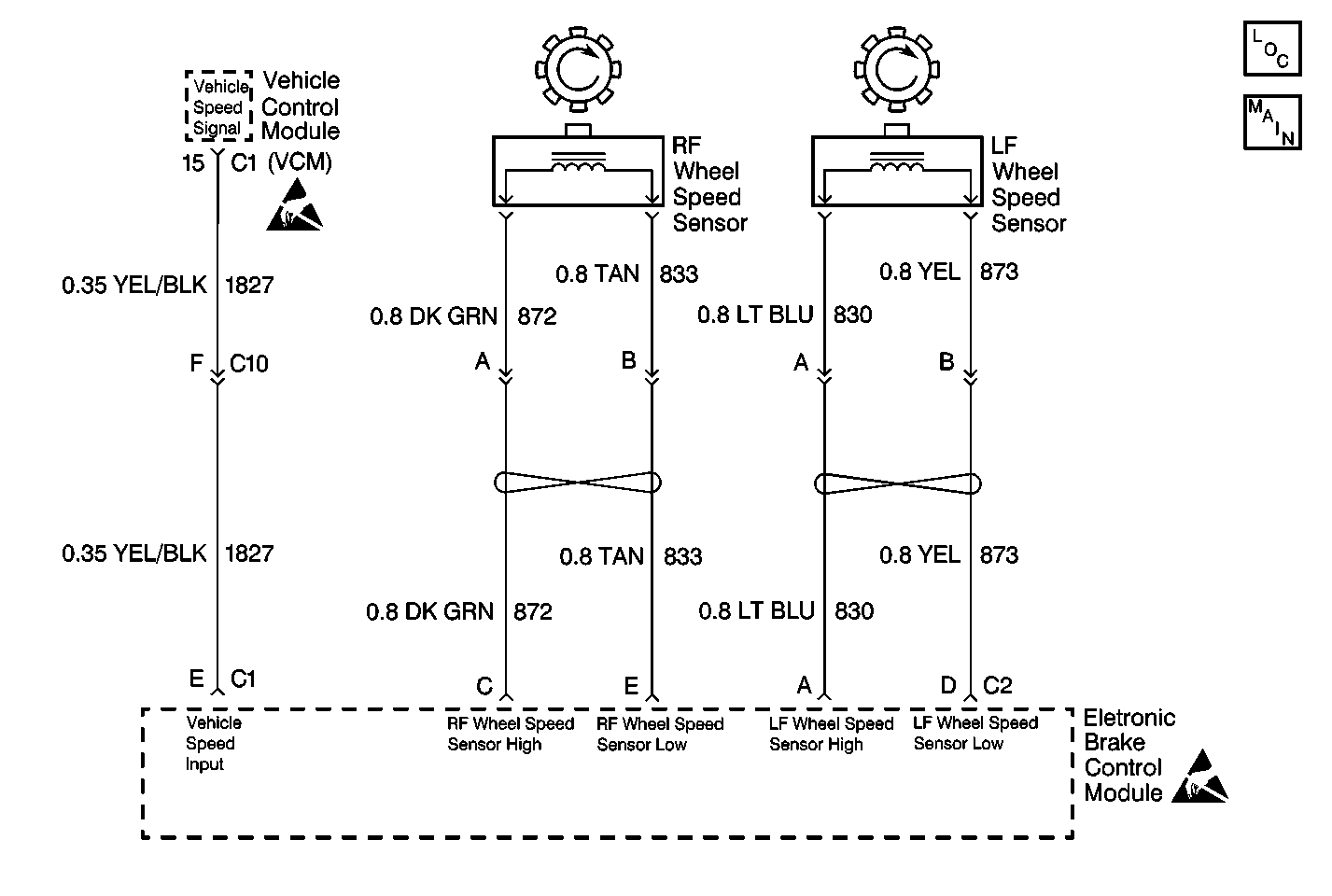
Circuit Description
The EBCM receives the rear wheel speed signal from the Vehicle Control Module (VCM). The rear wheel speed signal originates from the Vehicle Speed Sensor (VSS) which is connected to the VCM. The wheel speed sensor coil emits an electromagnetic field. A toothed ring on the wheel passes by the wheel speed sensor and disrupts its electromagnetic field. The disruption in the field causes the wheel speed sensor to produce a sinusoidal (AC) voltage signal. The frequency and amplitude of the sinusoidal (AC) voltage signal are proportional to the speed of the wheel. The amplitude of the wheel speed signal is also directly related to the distance between the wheel speed sensor coil and the toothed ring. This distance is referred to as the air gap.
Conditions for Setting the DTC
EBCM losing the rear wheel speed signal for at least 5 seconds while the vehicle is moving above 13 km/h (8 mph) with the brake pedal released.
Action Taken When the DTC Sets
| • | The ABS indicator lamp turns on |
| • | The ABS disables |
DTC C0236 is a Condition Latched DTC, which indicates that the above actions remain true only as long as the condition persists.
DTC C0236 is a DRP Critical DTC, which means that DRP is disabled and the BRAKE indicator lamp will also light.
Conditions for Clearing the DTC
| • | Repair the conditions responsible for setting the DTC. |
| • | Use the Scan Tool Clear DTCs function. |
| • | A Condition Latched DTC may exist momentarily, or constantly. In either case, the DTC will be stored in the EBCM memory until it is repaired, and/or the DTC is cleared. After the DTC is repaired and/or cleared and the ignition is turned to ON, the ABS lamp will remain lit until the EBCM completes a power-up self test. This test concludes when the vehicle has reached a speed of greater than 13 km/h (8 mph) and the wheel speed inputs have been checked by the EBCM. |
Diagnostic Aids
Check for and clear DTCs in the VCM first.
This DTC can be set by a faulty EBCM or a fault in CKT 1827.
In addition, any of the following conditions may cause an intermittent malfunction:
| • | A poor connection |
| • | Wire insulation that is rubbed through |
| • | A wire breaks inside the insulation |
Thoroughly check any circuitry that is suspected of causing the intermittent complaint for the following conditions:
| • | Backed out terminals |
| • | Improper mating |
| • | Broken locks |
| • | Improperly formed or damaged terminals |
| • | Poor terminal to wiring connections |
| • | Physical damage to the wiring harness |
If the customer says that the ABS indicator lamp is on only during humid conditions such as rain, snow, or vehicle wash, then thoroughly inspect the suspected circuits for signs of water intrusion. Use the following procedure:
- Spray the suspected area with a 5% salt water solution (two teaspoons of salt to 12 oz. of water).
- Drive the vehicle above 24 km/h (15 mph) for at least 30 seconds.
If the DTC returns, replace the suspected harness.
Test Description
The numbers below refer to the steps in the diagnostic table:
-
This step uses the voltage output from the VCM to check the 1827 CKT.
-
This step checks the 1827 CKT for proper resistance.
-
This step checks for a short in the wiring between the ECBM and the VCM.
Step | Action | Value(s) | Yes | No |
|---|---|---|---|---|
1 | Was the Diagnostic System Check performed? | -- | Go to Step 2 | |
Is the voltage measurement within the specified range? | Greater than 10 volts | Go to Step 4 | Go to Step 3 | |
Is the resistance measurement within the specified range? | 0-2ohms | Go to Step 5 | Go to Step 8 | |
4 |
Did the DTC set? | -- | Go to Step 6 | Go to Step 7 |
Using a J 39200 , measure the resistance from terminal E of the 10-way EBCM harness connector to ground. Is the resistance measurement within the specified range? | OL | Go to Step 9 | ||
6 | Replace the EBCM. Refer to Electronic Brake Control Module Replacement . Is the repair complete? | -- | -- | |
7 | Malfunction is intermittent.
Refer to Diagnostic Aids for more information. Is the repair complete? | -- | -- | |
8 | Repair the open in CKT 1827. Is the repair complete? | -- | -- | |
9 | Repair short to ground in CKT 1827. Is the repair complete? | -- | -- |
